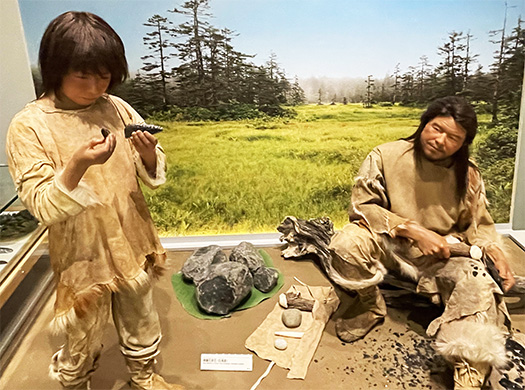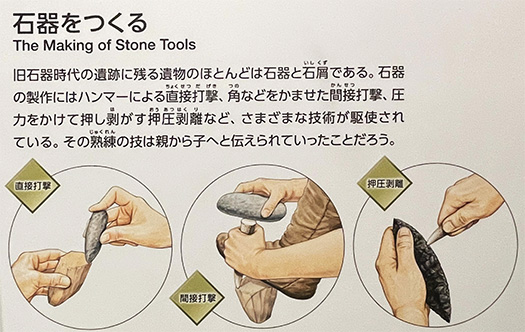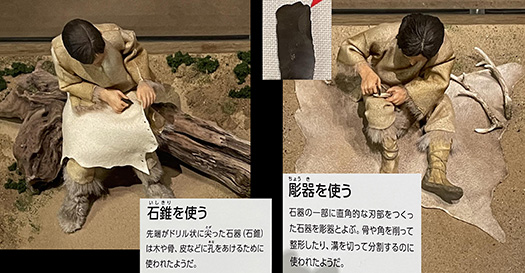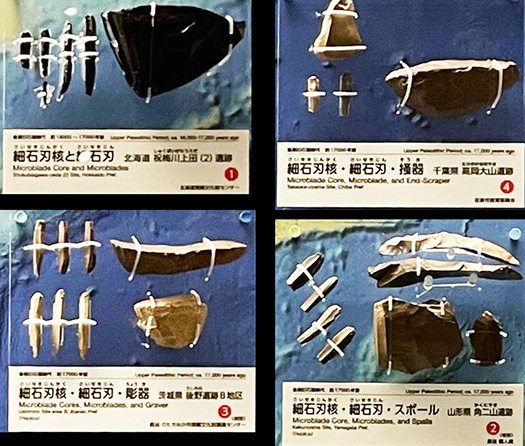


日本列島に残る旧石器時代人の痕跡・遺跡からの時代相探索。
時間にして37,000年前から縄文開始の約13,000年前まで
25,000年間くらいの時代相が相当する。
人間の世代更新をおおまかに20才として考えれば、1,250世代。
ジオラマのような親子の知恵の継承が不断に行われ続けた。
石器へのさまざまな工夫をもって人類は生き抜いてきた。
ちょうど子どもが石に向かって鋭利な注意力を向けている様子。
それを見つめる父親の表情になんともいえない感情がこもっている。
「この石、こんなふうに割れるんだ。この断面なら、こう使えるかなぁ」
「ようやくこいつも石器の向上に注意を持ち始めたか・・・」
石に向かって自分たちの生き方を進歩させる工夫を凝らす。
もっとも普遍的に存在する利器としての石を
道具にしていくという飛躍とその発展ぶりにこそ、
人類進化のさまざまな「要素」が発現していったのでしょう。
その要素が「止揚」されて現代世界にまで技術痕跡として繋がっている。
これは確実に存在した歴史事実。
イラスト表現では「直接打撃・間接打撃・押圧剥離」という技術手法解説。
人間という動物種が知恵というものを進化させたルーツ。
生き延びてくる中でいっときも休むことなく繰り返された営為。
「その割れ方はな、こうやればできるんだぞ」
「そうなんだ、でもこうやったらもっと良くないかなぁ、父ちゃん」
「おお、そういうのもアリだなぁ・・・」
たぶん進化のプロセスはこういう会話からだったのだろう。
こういう親子対話が1,250世代にわたって繰り返された結果、
進化プロセスが飽和沸点を超えて、時代画期として縄文の世が始まった。

道具を使ってより暮らしやすい環境を現実世界で実現する。
それまでの動物種にはみられない特殊な発展が人類だけに可能になった。
この石器の進化は同時代的に世界各地で進行して
やがてカミソリ状の鋭利な石器を組み合わせる細石刃文化に極まっていく。
石器時代の「最先端技術」。
この文化はシベリア・中国北部・朝鮮半島・日本列島と周辺全域に広がった。
列島での嚆矢は25,000年前頃、大陸と地続きだった北海道にやってきた。
以降その文化は広く日本列島に伝播していったとされる。
発展に当たって北海道白滝村地域の世界最高レベルの純度の黒曜石が
最高の原料とされ、その発掘生産のための社会組織的痕跡まで見られる。
「これメッチャいいべや〜、みんな欲しがるに違いない」
「こりゃぁ発掘の専門組織や、製品化の場所も必要だな・・・」
というような分業化の痕跡が見られるのだという。
世界規模での情報共有が相当の速度で伝わったことが推認される。
まさに道具の進化は情報交流の進化ももたらしたのだろう。
先人たちの生き抜く知恵に圧倒される。・・・
English version⬇
The History of Human Evolution in Stone Tools: The 37,000-Year History of the Japanese Archipelago – 9
The Stone Age’s most advanced technology, the “fine stone blade culture. Optimization of use brings about social development. Wide-area distribution and the development of information technology also progressed. The Stone Age
A search for chronological phases from the traces and remains of Paleolithic man in the Japanese archipelago.
From 37,000 years ago in time to about 13,000 years ago at the start of the Jomon period.
This corresponds to a period of about 25,000 years.
If we assume that the human generation renewal is roughly 20 years old, it is 1,250 generations.
Like a diorama, the wisdom of parents and children continued to be passed down from generation to generation.
Humans have survived through various innovations in stone tools.
A child is just turning his sharp attention toward a stone.
The father’s expression as he gazes at the child is filled with indescribable emotion.
The father’s face is filled with indescribable emotion as he looks at the stone. I wonder if this section can be used like this.
Finally, he is beginning to pay attention to the improvement of stone tools…”
They devise ways to advance their own way of life toward the stone.
The stone as the most universally existing useful tool.
The leap of turning stone into a tool and its development is what
The elements of human evolution were expressed in the leap and development of using stone as a tool.
These elements have been “sublimated” and connected to the modern world as technological traces.
This is a historical fact that has certainly existed.
In the illustration, the technical technique of “direct blow, indirect blow, and pressure peeling” is explained.
The roots of the evolution of wisdom in the animal species called human beings.
An activity that has been repeated without a moment’s pause in the course of survival.
You can do that cracking by doing it like this.
“Yes, but wouldn’t it be better this way, Dad?”
“Oh, that’s a good idea…”
Perhaps the evolutionary process began with these conversations.
After 1,250 generations of this kind of parent-child dialogue, the evolutionary process has reached a saturation boiling point.
The evolutionary process reached a saturation boiling point, and the Jomon period began.
We use tools to create a more comfortable living environment in the real world.
This special development, not seen in previous animal species, was possible only for humans.
This evolution of stone tools proceeded contemporaneously in various parts of the world.
This evolution of stone tools progressed contemporaneously in many parts of the world, eventually culminating in the fine stone blade culture, which combined razor-sharp stone tools.
This was the “cutting edge technology” of the Stone Age.
This culture spread throughout Siberia, northern China, the Korean peninsula, the Japanese archipelago, and surrounding areas.
The first pioneering example of this culture in the archipelago came to Hokkaido, which was connected to the continent around 25,000 years ago.
Since then, the culture is believed to have spread widely throughout the Japanese archipelago.
The world’s purest obsidian from the Shirataki Village area of Hokkaido was considered the best raw material for the development of the culture.
The obsidian found in the Shirataki Village area of Hokkaido was considered to be the best raw material, and there are even traces of the social organization that was involved in its excavation and production.
This is so good, everyone will want it.
“This is great, everyone will want it…” “We need an organization specializing in excavation and a place to commercialize it…”
We need an organization specializing in excavation and a place to commercialize the product….
It can be inferred that information sharing on a global scale was transmitted at a considerable speed.
The evolution of tools must have brought about the evolution of information exchange.
I am overwhelmed by the wisdom of our ancestors to survive. The wisdom of our ancestors to survive is overwhelming.
Posted on 10月 14th, 2022 by 三木 奎吾
Filed under: 日本社会・文化研究, 歴史探訪







コメントを投稿
「※誹謗中傷や、悪意のある書き込み、営利目的などのコメントを防ぐために、投稿された全てのコメントは一時的に保留されますのでご了承ください。」
You must be logged in to post a comment.